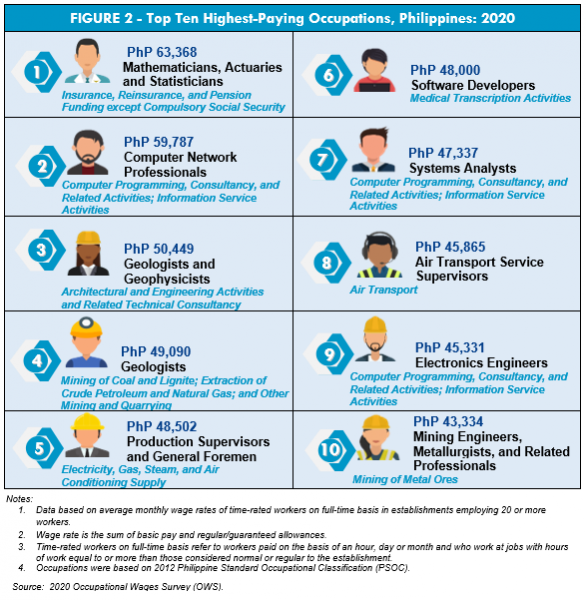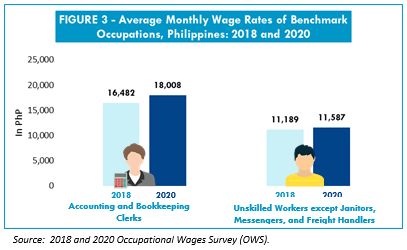AVERAGE MONTHLY WAGE RATES OF SELECTED OCCUPATIONS: 2018 AND 2020
- Of the 190 monitored occupations across the covered industries, the average monthly wage rate of time-rated workers on full-time basis was recorded at
PhP 16,486 in 2020, a-9.0 percent decrease from thePhP 18,108 posted in 2018. (Figure 1)

TOP TEN HIGHEST-PAYING OCCUPATIONS: 2020
Among the various time-rated workers on full-time basis, the highest average monthly wage rate was recorded for mathematicians, actuaries, and statisticians in insurance, reinsurance, and pension funding except compulsory social security at
PhP 63,368 in 2020. (Figure 2)
Computer network professionals in computer programming, consultancy, and related activities; information service activities ranked second with an average wage rate of
PhP 59,787 per month.
Meanwhile, geologists from two different industry groups came in third and fourth receiving monthly average wage rates of PhP 50,449 (architectural and engineering activities and related technical consultancy) and PhP 49,090 (mining of coal and lignite; extraction of crude petroleum and natural gas; and other mining and quarrying), respectively.

Production supervisors and general foremen engaged in electricity, gas, steam, and air conditioning supply received an average of
PhP 48,502 a month, making them in the top five.
Other occupations under Information and Communications Technology (ICT) were also included in the top 10 highest paid jobs such as: software developers in medical transcription activities
(PhP 48,000) ; and system analysts(PhP 47,337) and electronics engineers(PhP 45,331) both in computer programming, consultancy, and related activities; information services activities.
AVERAGE MONTHLY WAGE RATES OF BENCHMARK OCCUPATIONS: 2018 AND 2020
The average wage rate of accounting and bookkeeping clerks across all industries was estimated at
PhP 18,008 per month in 2020, an increase of9.3 percent fromPhP 16,482 in 2018. (Figure 3 and Table 1)
Among all industries, the accounting and bookkeeping clerks employed in electricity, gas, steam, and air conditioning supply received the highest average monthly wage rate of
PhP 29,713 in 2020. This translates to 6.3 percent increment relative toPhP 27,939 average monthly wage rate recorded on the same industry in 2018.

On the other hand, the average wage rate of unskilled workers except janitors, messengers, and freight handlers for all industries grew by only
3.6 percent , fromPhP 11,189 registered in 2018 toPhP 11,587 per month in 2020. (Figure 3 and Table 1)
Similarly, unskilled workers engaged in electricity, gas, steam, and air conditioning supply industry received the highest average monthly wage rate of
PhP 18,955 among all industries, which was23.2 percent higher than PhP 15,387 posted on the same industry in 2018.
MEDIAN MONTHLY BASIC PAY: 2018 AND 2020
- The median monthly basic pay of time-rated workers on full-time basis across all industries was registered at PhP 13,646 in 2020 or a
0.6 percent increase from PhP 13,559 in 2018. (Table 2)
A. Median Monthly Basic Pay by Major Industry Group
- By major industry group, 13 out of 18 covered industries in 2020 had a higher median monthly basic pay compared to all industries (PhP 13,646).
- Time-rated workers engaged in electricity, gas, steam, and air conditioning supply registered the highest median monthly basic pay of PhP 27,253, a 10.7 percent increase from PhP 24,627 in 2018.
- The median monthly basic pay of workers in mining and quarrying industry significantly increased by 14.5 percent or a monthly basic pay of PhP 13,272 in 2020 from PhP 11,590 in 2018. Meanwhile, the biggest decline was posted in financial and insurance activities at -13.5 percent or PhP 2,500 lower than the median basic pay of PhP 18,486 per month in 2018.
B. Median Monthly Basic Pay and Allowance of Time-Rated Workers by Sex
Female time-rated workers reported a little higher median monthly basic pay of
PhP 14,051 compared to PhP 13,467 received by male workers in 2020 for all industries. (Table 3)
Similarly, the median allowance is higher for female workers receiving
PhP 2,507 per month compared to their male counterparts atPhP 2,410 in 2020.
MEDIAN MONTHLY ALLOWANCE BY MAJOR INDUSTRY GROUP: 2018 AND 2020
The median monthly allowance of time-rated workers on full-time basis was recorded at
PhP 2,456 in 2020, a significant increase of43.1 percent from PhP 1,716 in 2018. (Table 4)Forty-four percent of the covered industries (8 out of 18) in 2020 had higher median monthly allowance than that of all industries level.Across industries, workers engaged in arts, entertainment, and recreation had the highest median allowance of
PhP 6,119 per month.
PERCENT DISTRIBUTION OF TIME-RATED WORKERS BY RANGE OF MONTHLY BASIC PAY AND ALLOWANCE: 2020
Half (50.3%) of the time-rated workers on full time basis received a monthly basic pay ranging from
PhP 11,000 toPhP 20,999 while31.3 percent received belowPhP 11,000 . Meanwhile, only3.5 percent received basic pay ofPhP 31,000 toPhP 40,999 per month. (Figure 4)A great majority of time-rated workers
(65.9%) did not receive monthly allowance in 2020. Further,17.4 percent received monthly allowance belowPhP 2,500 while only1.0 percent had allowances ranging fromPhp 11,500 to PhP 15,999 per month . (Figure 5)





Technical Notes
The 2020 Occupational Wages Survey (OWS) is a nationwide survey of establishments which employ 20 or more workers. It is conducted every two (2) years to monitor the wage rates of two (2) benchmark occupations and at most eleven (11) occupations in each of the pre-determined 55 out of the 71 industries. In addition to the two benchmark occupations i.e., (1) accounting and bookkeeping clerks; and (2) unskilled workers (except janitors, messengers, and freight handlers), a total of 190 industry-specific occupations were monitored for 2020 OWS.
The 2020 OWS adopted the 2012 Philippine Standard Occupation Classification (PSOC) from the 2002 PSOC Update used in the 2016 round. Changes in the listing of occupations include splitting of some classification codes into different codes/groups, e.g., Electronics and Telecommunications Engineer 2153 (2002 PSOC Update) into Electronic Engineer 2152 (2012 PSOC) and Telecommunications Engineer 2153 (2012 PSOC). This also resulted in the merging of some classification codes/group (i.e. Travel Consultant and Organizer 3114 (2002 PSOC Update) and Travel Agency Clerks and Related Workers 4211 (2002 PSOC Update) into Travel Consultants and Clerks 4221 (2012 PSOC).
The main objective of the 2020 OWS is to generate wage statistics as critical inputs to policies on wage and salary administration and wage determination particularly in wage-fixing, price policies and collective bargaining negotiations. The OWS is one of the designated statistical activities identified under Executive Order No. 352 (System of Designated Statistics) dated July 1, 1996 which recognized the survey as an activity that will generate critical data for decision-making of the government and the private sector.
Specifically, statistics on wage rates are useful economic indicators and inputs to wage, income, productivity and price policies, and wage fixing in collective bargaining. Occupational wage rates are used to measure wage differences across occupations and industries specifically wage differentials and wage inequality in typically low wage and high wage occupations. Industry data on basic pay and allowances can be used to measure wage differentials across industries, for investment decisions and as reference in periodic adjustments of minimum wages. The wage data collected from the OWS can be used for international comparability as the industry codes and occupation codes used in the survey are the current standard codes used internationally.
The reference period for the 2020 OWS covers the pay period that includes 31 August 2020. The main topics covered by the survey include occupational wage rates, median basic pay and median allowance of time-rated workers on full-time basis. The data category on “average monthly occupational wage rate of selected occupations” is one of the important variables listed by the Philippine government under the Special Data Dissemination Standard (SDDS) of the International Monetary Fund (IMF). The SDDS serves as reference to member countries in the dissemination of economic and financial data
Definition of Terms:
Basic pay - includes pay for normal/regular working time before deductions for employees’ social security contributions (e.g., SSS/GSIS, PhilHealth, PAG-IBIG) and withholding taxes, etc. However, basic pay excludes overtime, night shift differential and other premium pays; commissions, tips and shares of employees in service charges; payments in kind; allowances; and bonuses and gratuities.
Allowances - include cost of living allowances (COLA) and other guaranteed cash payments given regularly. It excludes, however, reimbursements for travel, entertainment, meals, and other expenses, etc. incurred in conducting the business of the employer; cost of uniform/working clothes; bonuses and gratuities; family allowances; and payments in kind.
Time-rated workers on full-time basis - workers paid on the basis of a time unit of work and who work at jobs with hours of work equal to or more than those considered as normal or regular to the establishment.
Time unit - basis of computing, determining or fixing the basic pay or allowance, i.e., hourly, daily or monthly. This is different from frequency of payment such as twice a month.
Wage rate - refers to the sum of basic pay and regular/guaranteed cash allowances.
Benchmark occupations - refer to occupations monitored in all industries covered by the survey. It serves as a standard or point of reference against which other occupations may be compared or assessed. The OWS specifically collects data on these two benchmark occupations: (1) Accounting and Bookkeeping Clerks and (2) Unskilled Workers except Janitors, Messengers, and Freight Handlers
Median - refers to the value that divides the wage distribution into two equal parts. It is the value where half of the distribution receive more while the other half receive less.
DENNIS S. MAPA, Ph.D.
Undersecretary
National Statistician and Civil Registrar General
See more at the Occupational Wages Survey Landing Page.
